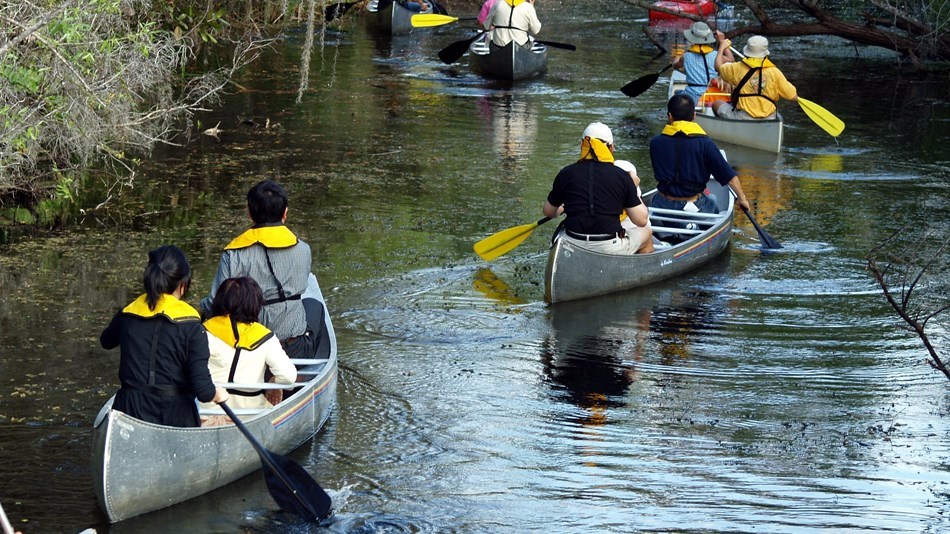Last updated: June 15, 2018
Article
On The Water At Last!

NPS Photo
On the water at last! You have prepared yourself and your vessel for your trip and are ready to enjoy your water adventure. Follow the tips below to help your fun adventure be a safe one too:
Check the Weather and Water Temperatures
-
Never leave the dock without checking the weather forecast. Look at the local weather information or check with the park to see if severe weather is in the forecast.
-
Check the water temperature. Just because it’s hot outside, it does not mean that the water is warm. Natural bodies of water can be very cold, even during the summertime. Even if you don’t intend to get in the water while out on your vessel, you should prepare for this situation. Depending on your activity and the likelihood of ending up in the water, for example while paddleboarding or kayaking, you may need a wetsuit to help keep you warm.
-
Learn the signs and symptoms of hypothermia. Hypothermia can begin to occur in water that is 80 degrees or colder, depending on your health, body composition, clothes you are wearing and other factors. Hypothermia causes your body temperature to drop below 98.6 degrees. Symptoms can range from mild to severe - impacting your ability to think and move to becoming unconscious leading to possible death. Know when to get out of the water and what to do if someone experiences hypothermia
-
Don’t take the chance-- have a plan if you or others fall into cold water. No one plans to fall overboard while boating, but accidents do happen. Read our water safety tips to be prepared if you or someone in your vessel falls overboard and needs to be rescued.
-
Keep a ‘weather eye’ out. The weather conditions can quickly change throughout the day. Pay attention and know what severe weather looks like.
-
Beat the bad weather and get to shore. Do not get caught out on the water during a storm. If you see severe weather approaching, head to the shore. It’s easier to escape a storm before it hits. Boat ramps become crowded after the storm arrives.
-
Respond when the storm hits. If you get caught out on the water during severe weather, get all swimmers and skiers into the boat, make sure everyone is wearing a life jacket, secure loose items and make your way to calmer waters in a sheltered cove or inlet.
Be Aware When Out on the Water
-
Always wear your U.S. Coast Guard approved life jacket. It is nearly impossible to put on a life jacket after you’ve fallen in. And, if you left it in the boat you won’t be able to reach it. Don’t take the risk of drowning by not wearing a life jacket. Be sure it fits! Life jackets that are too loose frequently come off when someone falls into the water. Life jackets that are too small won’t provide enough flotation to keep your head above water. Wear a lifejacket when you are being towed (water skiing, inflatable, etc. )
-
Sit only in designated seats on your vessel. Do not sit on the edge of your vessel or in places that are not designated seats, like the bow, the transom, or engine cover. Do not lean over the edge of your vessel, sit on the bow, or stand on any platforms outside of the vessel while it is moving. Sitting or standing in these locations while the vessel is underway can result in you being thrown overboard. In addition, you can be cited for having passengers riding in an unsafe position while operating your vessel.
-
Know when to use a leash with your stand-up paddleboard. Research what type of leash you will need for the type of water conditions where you plan to paddle (swift water, surf, etc.) and when you should use it.
-
Look out for swimmers and divers. Some parks allow visitors to swim and scuba dive in the water. Pay attention to signs, buoys, flags, and marked areas that indicate where swimmers or divers may be.
-
Turn off the motor when people are in the water near the vessel. The motor should not be on when people are swimming around or near the vessel. Avoid any chance of someone getting struck by the propeller.
-
Be aware of carbon monoxide poisoning risks. If your boat has a gas motor or generator, there is the risk of being exposed and potentially poisoned by carbon monoxide. Carbon monoxide can harm or even kill you while you are in or around your boat. Learn more about what it is, where it can occur on, in, or around a vessel, and how to prevent poisoning.
- Be respectful of others on the water. Share the waters and don’t get too close to other vessels. If you are towing someone, make sure the towline is the appropriate length and does not interfere with others recreating.
Plan and prepare for your trip with help from the NPS Trip Planning Guide and learn more about your Health & Safety in national parks.
